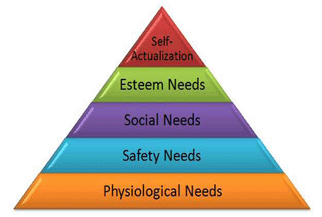 Abraham Maslow is well renowned for proposing the Hierarchy of Needs Theory in 1943. This theory is a classical depiction of human motivation. This theory is based on the assumption that there is a hierarchy of five needs within each individual. The urgency of these needs varies.
Abraham Maslow is well renowned for proposing the Hierarchy of Needs Theory in 1943. This theory is a classical depiction of human motivation. This theory is based on the assumption that there is a hierarchy of five needs within each individual. The urgency of these needs varies. These five needs are as follows-
1. Physiological needs- These are the basic needs of air, water, food, clothing and shelter. In other words, physiological needs are the needs for basic amenities of life.
2. Safety needs- Safety needs include physical, environmental and emotional safety and protection. For instance- Job security, financial security, protection from animals, family security, health security, etc.
3. Social needs- Social needs include the need for love, affection, care, belongingness, and friendship.
4. Esteem needs- Esteem needs are of two types: internal esteem needs (self- respect, confidence, competence, achievement and freedom) and external esteem needs (recognition, power, status, attention and admiration).
5. Self-actualization need- This include the urge to become what you are capable of becoming / what you have the potential to become. It includes the need for growth and self-contentment. It also includes desire for gaining more knowledge, social- service, creativity and being aesthetic. The self- actualization needs are never fully satiable. As an individual grows psychologically, opportunities keep cropping up to continue growing.
According to Maslow, individuals are motivated by unsatisfied needs. As each of these needs is significantly satisfied, it drives and forces the next need to emerge. Maslow grouped the five needs into two categories - Higher-order needs and Lower-order needs. The physiological and the safety needs constituted the lower-order needs. These lower-order needs are mainly satisfied externally. The social, esteem, and self-actualization needs constituted the higher-order needs. These higher-order needs are generally satisfied internally, i.e., within an individual. Thus, we can conclude that during boom period, the employees lower-order needs are significantly met.
Implications of Maslow’s Hierarchy of Needs Theory for Managers
ü As far as the physiological needs are concerned, the managers should give employees appropriate salaries to purchase the basic necessities of life. Breaks and eating opportunities should be given to employees.
ü As far as the safety needs are concerned, the managers should provide the employees job security, safe and hygienic work environment, and retirement benefits so as to retain them.
ü As far as social needs are concerned, the management should encourage teamwork and organize social events.
ü As far as esteem needs are concerned, the managers can appreciate and reward employees on accomplishing and exceeding their targets. The management can give the deserved employee higher job rank / position in the organization.
ü As far as self-actualization needs are concerned, the managers can give the employees challenging jobs in which the employees’ skills and competencies are fully utilized. Moreover, growth opportunities can be given to them so that they can reach the peak.
The managers must identify the need level at which the employee is existing and then those needs can be utilized as push for motivation.
Limitations of Maslow’s Theory
* It is essential to note that not all employees are governed by same set of needs. Different individuals may be driven by different needs at same point of time. It is always the most powerful unsatisfied need that motivates an individual.
* The theory is not empirically supported.
* The theory is not applicable in case of starving artist as even if the artist’s basic needs are not satisfied, he will still strive for recognition and achievement.
Source: managementstudyguide.com
feel free to visit http://www.mbaslides.com/site/index.php where you can download mba study materials in the form PPT, PDF, DOC
ReplyDelete